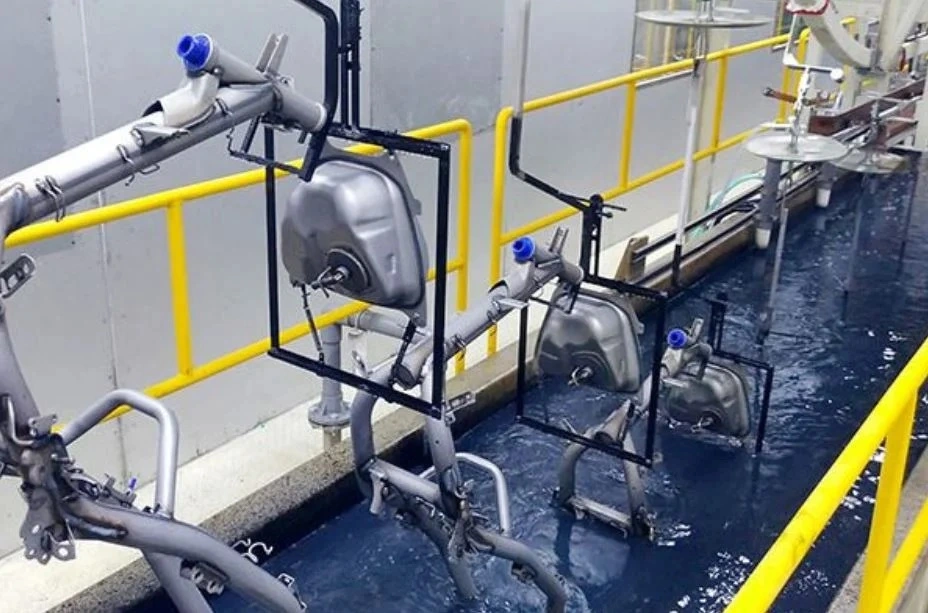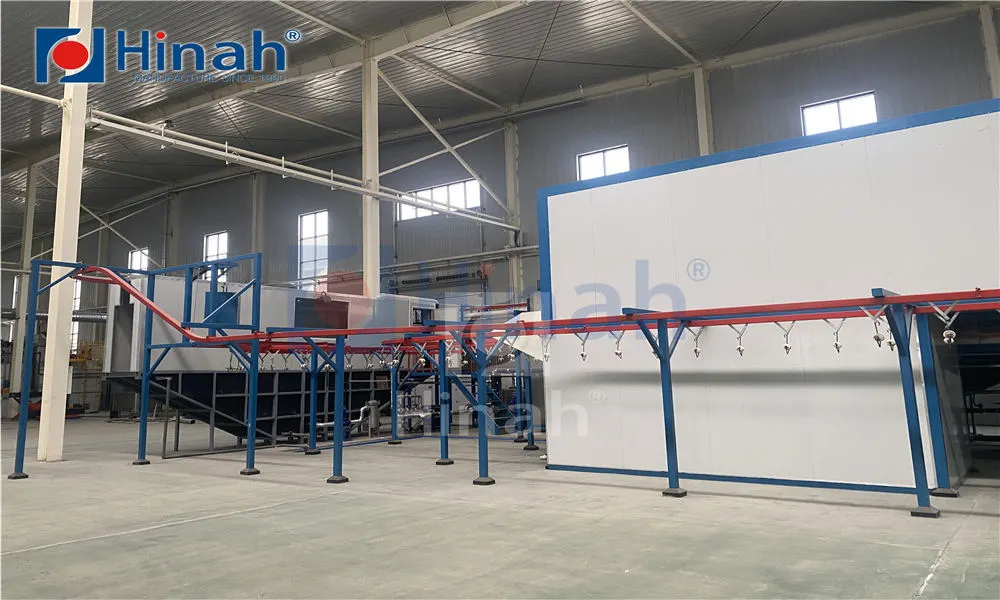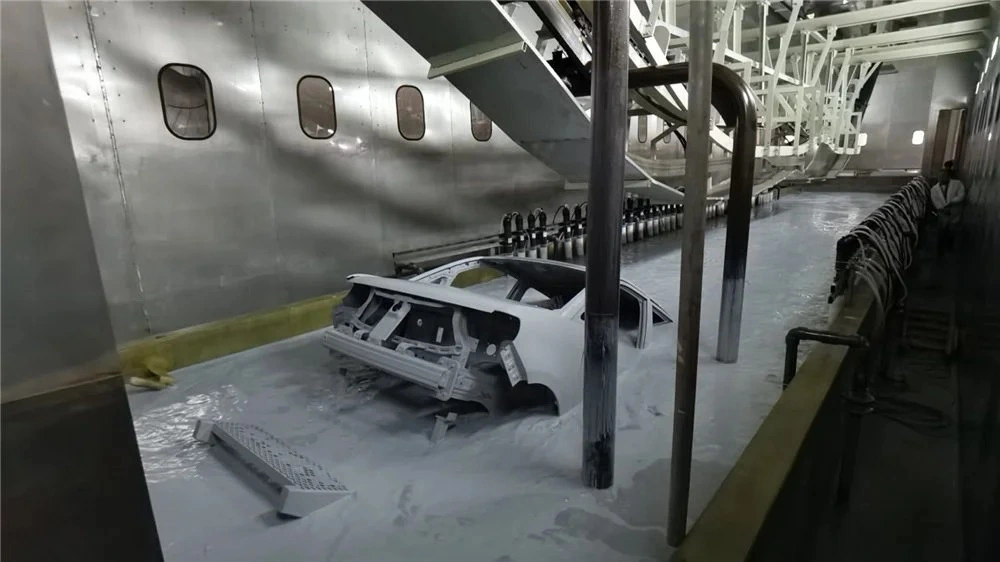Walking into a well-organized powder coating facility, you're witnessing the culmination of meticulous planning and engineering. The hum of the curing oven, the smooth flow of the conveyor, and the consistent quality of finished parts don't happen by accident. They are the result of a carefully executed powder coating plant setup. For any business owner or operations manager, embarking on this project is a significant undertaking. It's a complex process where every decision, from floor space allocation to technology selection, has a direct impact on your bottom line, product quality, and operational efficiency.
This definitive guide breaks down the powder coating plant setup process into seven manageable, essential steps. By following this roadmap, you can avoid common pitfalls, control costs, and build a finishing operation that becomes a core strength of your manufacturing process. As a global leader in industrial finishing solutions, HANNA has guided countless companies through this journey, and we're sharing our expertise to help you build with confidence.

Step 1: The Foundation - Comprehensive Project Assessment and Planning
Before you purchase a single piece of equipment, the most critical phase begins on paper. A successful powder coating plant setup is rooted in a deep understanding of your own requirements. This stage involves asking the fundamental questions:
What are you coating? Document the size, weight, material (steel, aluminum, etc.), and geometry of your typical parts. This will dictate the size of your pre-treatment tanks, ovens, and conveyor system.
What is your production volume? Determine your required throughput in parts per hour or square meters per shift. This defines the speed and capacity of your entire line.
What are your quality and compliance standards? Are you meeting commercial standards or more stringent specifications for automotive or architectural work? This influences your pre-treatment and curing technology choices.
What is your available space and budget? Conduct a realistic audit of your facility's footprint and financial resources.
Creating a detailed project charter at this stage is non-negotiable. It becomes the blueprint that guides all subsequent decisions for your powder coating plant setup.
Step 2: Mastering the Layout and Flow for Maximum Efficiency
The physical layout of your plant is the skeleton of your operation. An inefficient layout creates bottlenecks, increases material handling costs, and hinders workflow. The goal is to create a logical, linear, and safe flow of parts from the raw loading area, through each process stage, to the final unloading of cured products.
Consider factors like:
Line Type: A straight-through I-line is simple, while a U-shaped or overhead conveyor loop can save significant floor space.
Process Proximity: Positioning the spray booth immediately after the drying oven, for instance, minimizes the travel distance for delicate, pre-treated parts.
Utility Access: Ensure easy access to electrical panels, gas lines, and compressed air drops for maintenance.
Future Expansion: A smart layout leaves room for scaling up production in the future.
A well-designed floor plan is a hallmark of a professional powder coating plant setup, directly impacting productivity and safety.
Step 3: Selecting the Core Technology - Pre-Treatment, Application, and Curing
This is the heart of your operation. Your powder coating plant setup relies on three core technological systems working in harmony:
Pre-Treatment System: This is the most overlooked yet critical step for quality. Choose between a spray washer (common for most applications) or an immersion system (for complex parts). The number of stages (e.g., 3-stage: clean, rinse, seal; or 5-stage with conversion coating) depends on your corrosion resistance requirements.
Application System: This includes the spray booth, powder pumps, guns (manual, automatic, or both), and the critical powder recovery system. Modern recovery systems can achieve over 99% efficiency, making powder coating an environmentally conscious choice.
Curing System: The curing oven must be precisely sized to bring your specific parts to the required temperature for the exact time specified by the powder manufacturer. The choice between gas and electric, or convection and infrared technology, will significantly impact your energy costs and cure times.
For unique applications, a custom powder coating plant design from HANNA ensures these components are perfectly tailored to your specific parts and production goals.

Step 4: The Backbone - Designing the Material Handling and Conveyor System
The conveyor system is the central nervous system of your powder coating plant setup. It physically links all the other components and dictates the pace of your entire operation. The choice of conveyor is paramount:
Overhead Monorail Conveyors: The most common choice, excellent for saving floor space and handling a wide variety of parts.
Power & Free Systems: Offer greater flexibility, allowing parts to stop, accumulate, and be routed to different lines—ideal for complex manufacturing environments.
Floor Conveyors: Such as belt or roller conveyors, are suitable for heavier, flat-bottomed products like panels.
The conveyor must be engineered to handle the maximum weight and size of your parts, including the fixtures, and must be corrosion-resistant to withstand the pre-treatment environment.
Step 5: Navigating Regulatory Compliance and Environmental Considerations
A responsible powder coating plant setup must proactively address environmental, health, and safety regulations. Key considerations include:
Air Permits: While powder coating produces negligible VOCs, the burners in your ovens may require permits.
Wastewater Discharge: Pre-treatment generates wastewater that must be treated, either on-site or by a licensed hauler, before disposal.
Building Codes: Ensure your facility can handle the structural loads of the equipment and meets all fire safety codes for industrial ovens.
Worker Safety: Implement proper ventilation, fire suppression systems, and personal protective equipment (PPE) protocols.
Partnering with an experienced provider like HANNA helps you navigate this complex regulatory landscape, ensuring your plant is compliant from day one.
Step 6: The Power of Automation and Control Systems
In today's competitive landscape, a manual operation is a limited one. Integrating automation and centralized control into your powder coating plant setup is a game-changer. A modern Programmable Logic Controller (PLC) with a touch-screen interface allows you to:
Store and recall recipes for different products.
Precisely monitor and control oven temperatures and conveyor speeds.
Track energy consumption and production data.
Receive diagnostic alerts for predictive maintenance.
This level of control minimizes human error, ensures consistent quality, and provides valuable data for optimizing your entire process.
Step 7: Partnering for Success - Choosing the Right Equipment Supplier
The final step is perhaps the most crucial: selecting your technology partner. Your supplier should be more than a vendor; they should be a consultant and a long-term support system. Look for a company with:
A proven track record of successful powder coating plant setup projects.
The engineering capability to provide a custom powder coating plant solution.
Comprehensive in-house manufacturing and service support.
Transparent communication and project management.
HANNA embodies this partnership approach, offering turnkey solutions that encompass design, manufacturing, installation, and lifetime support, ensuring your investment delivers returns for years to come.
A successful powder coating plant setup is a strategic investment that pays dividends in product quality, operational efficiency, and market competitiveness. By methodically working through these seven steps—from rigorous planning and smart layout design to selecting the right technology partner—you lay a solid foundation for a world-class finishing operation. Remember, you're not just installing equipment; you're building a core capability for your business. Trust that capability to a partner with a global reputation for excellence. Trust it to HANNA.
Frequently Asked Questions (FAQs)
Q1: What is the typical budget range for a complete powder coating plant setup?
A1: The cost can vary dramatically based on scale and automation. A small, manual batch operation can start around $150,000, while a large, fully automated, custom powder coating plant with advanced pre-treatment can easily exceed $1-2 million. A detailed feasibility study with a supplier like HANNA is the best way to establish an accurate budget.
Q2: How long does it take from project approval to a fully operational plant?
A2: A typical timeline for a mid-sized powder coating plant setup is 6 to 9 months. This includes detailed engineering (1-2 months), equipment manufacturing (3-4 months), and on-site installation and commissioning (1-2 months). More complex projects will naturally take longer.
Q3: Can I set up a powder coating plant in a shared or multi-use facility?
A3: Yes, but it requires careful planning. Key considerations include physical segregation of the finishing area, dedicated utility services, and robust containment of powder and pre-treatment chemicals to prevent contamination of other manufacturing processes.
Q4: What are the most common mistakes to avoid during plant setup?
A4: The most common pitfalls are underestimating space requirements, undersizing the electrical and gas services, neglecting the importance of a high-quality pre-treatment system, and failing to plan for adequate ventilation and material handling around the line.
Q5: Why should I consider a custom powder coating plant over a standard package?
A5: A custom powder coating plant is engineered specifically for your parts, throughput, quality standards, and facility. This results in a more efficient workflow, lower operating costs (energy, labor, powder), higher quality output, and a better return on investment than trying to force-fit a standard package into a unique production environment.








